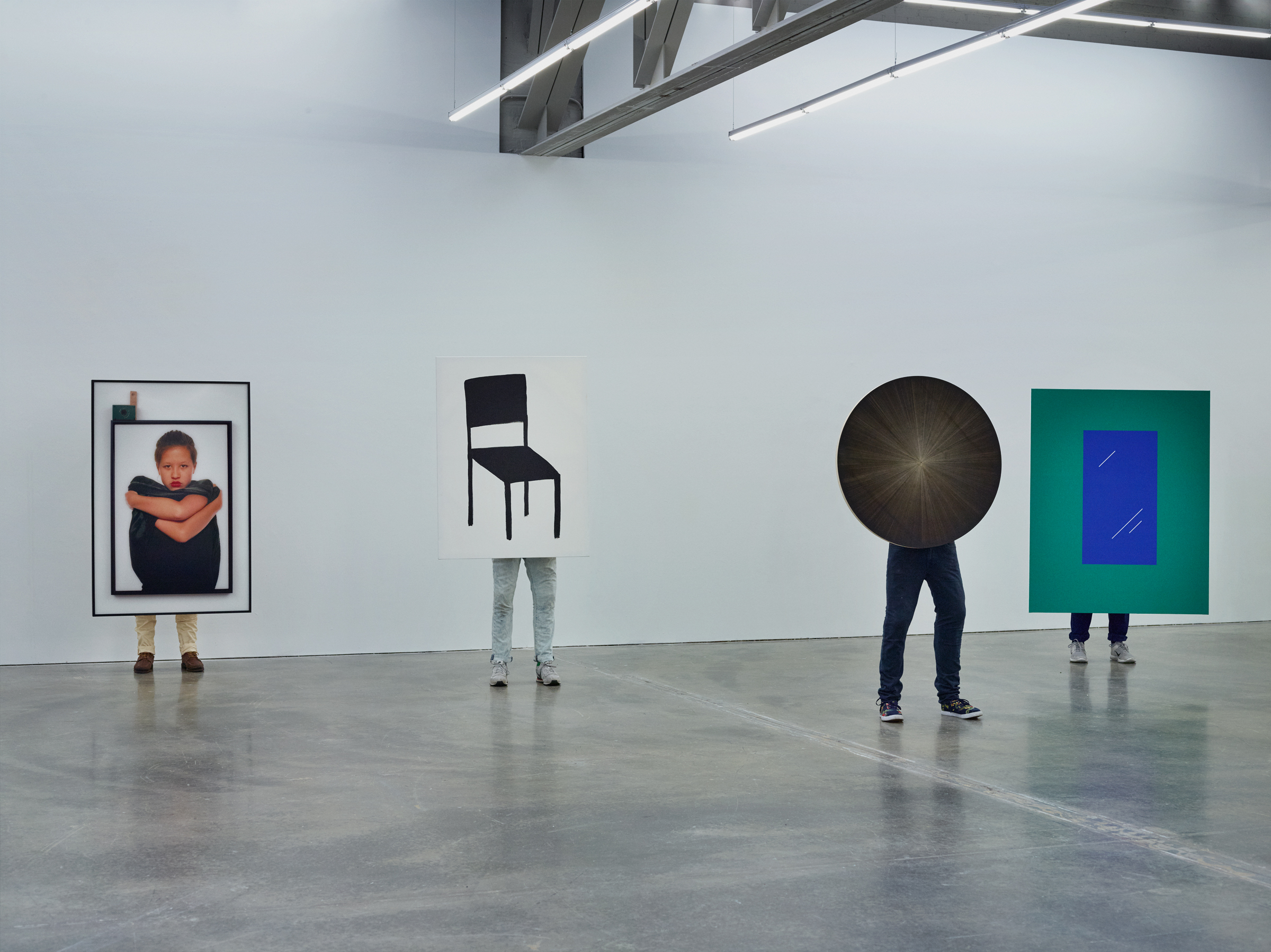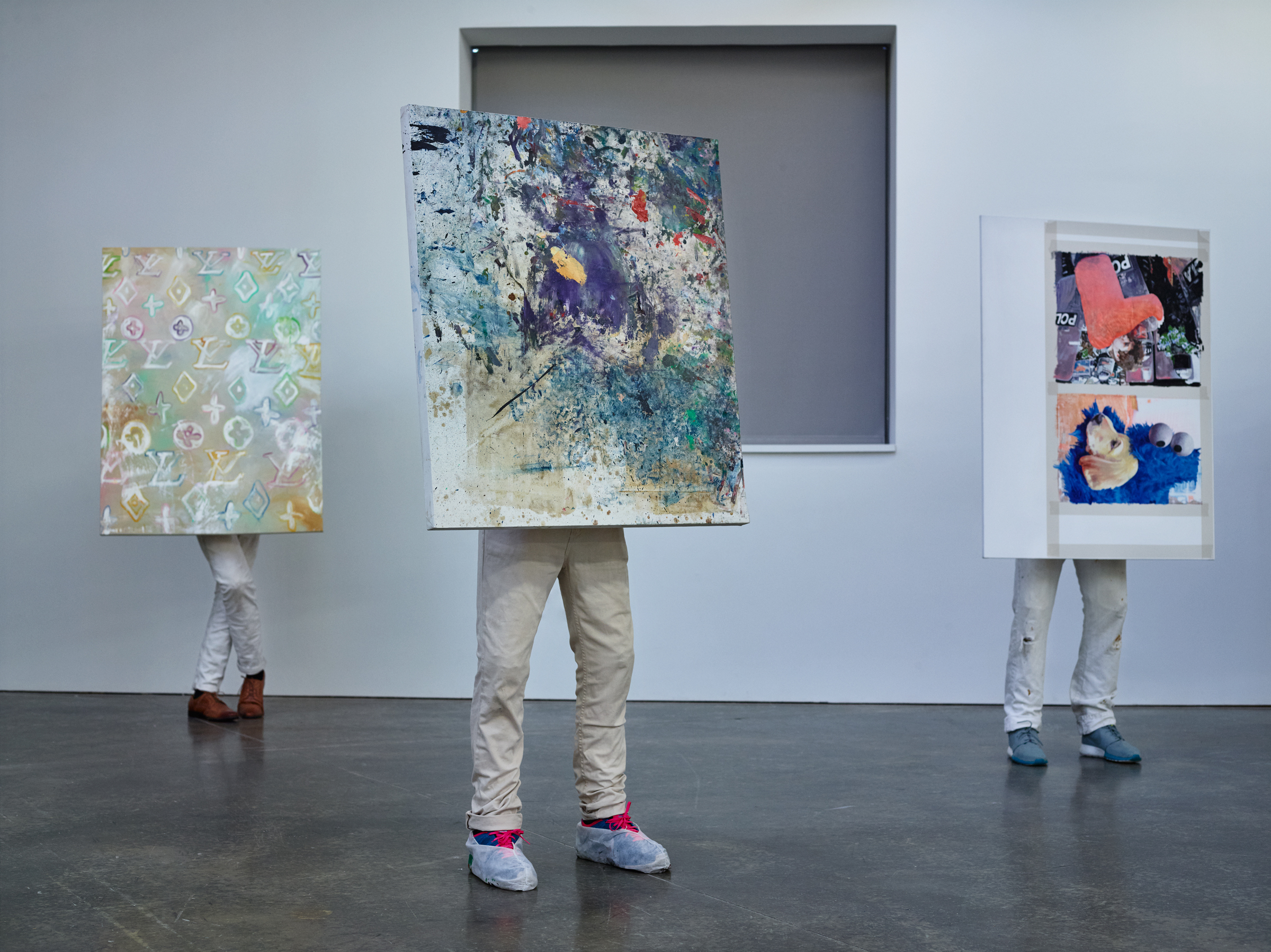John Riepenhoff’s current exhibition at Atlanta Contemporary consists of two parts: first, a collection of large-scale plein air paintings that depict the artist’s observations of the night sky, executed at Atlanta Contemporary in summer 2015.
The second half of his solo exhibition includes a series of collaborative figurative sculptures—papier-mâché legs outfitted in Riepenhoff’s pants and shoes (‘Handlers’) holding large-scale paintings by artists from Milwaukee, Chicago, New York and Atlanta. Here, Daniel Fuller, curator at Atlanta Contemporary, talks to Riepenhoff.
Do the Handlers put the artist and the often-unseen support systems for the artists on the same ground?
Yeah, when I started this series I was working as both an artist assistant and running an exhibition space. I was making art too but didn’t really identify as an artist: most of my energy went into creating infrastructure and an audience for other’s art. The Handlers literally support other artists’ work, are a new type of frame. They also have qualities of a venue because they add new context. You’re right that they are inviting labour and support structure to be more foregrounded in the picture, but unlike the paintings which they support they are mediators between the ground and an idea. The legs look silly on their own, topless, they need a painting, they need gravity and ground. In that way they are a platform or conduit between your venue and an artist’s painting, designed to expand the places our art-viewing experience story can comfortably wander.
Giving a number of tours of the exhibition, the great debate between many of the visitors seems to be whether the papier-mâché legs for the Handler pieces—which are cast from your torso and are wearing your clothing—are humorous or creepy. Care to weigh in?
That’s nice to hear. The impetus for this series came from wanting to actually share the comic perspective install-insiders get to see on a regular basis: someone walking around the gallery with a painting as the top half of their body. I haven’t quite figured out how to make the sculptures walk yet but am happy that your gallery visitors are responding to the theatre of seeing a painting floating off the wall. Yeah, I still get spooked when I see the headless pair of realistic legs around my studio or when I enter a room and first spot them in it. There’s also a little play on the dilemma painters juggle every time they make a piece, translating thoughts into material, paintings representing thoughts and the body representing physical production. Does that tickle or make you squirm?
Can you talk about the decision to cut a large slit into one of your large-scale plein-air paintings?
That’s the backstage pass to the show. On the stage of the gallery the painting becomes a backdrop for the art handlers to do their thing and in order to sneak people in behind them I had to cut an entrance through one of the large paintings. Come in the back way and you get to see the trick behind the easels holding paintings. Walk in the front and you might think 11 assistants are patiently floating the work in the middle of the room for you.
The work resting on the Handlers primarily comes from artists who you have collaborated with, in various ways, before. Can you talk about the inclusion of Atlanta-based Kojo Griffin?
Sure. I actually got to meet a lot of people living and making stuff in Atlanta leading up to the opening. Kojo was making paintings bend through game-like boards. They were pretty weird, canvas and paint twisting through whitewashed wooden painting architecture made a nice connection to paintings travelling from an artist’s studio to networks of galleries and museums like what was happening in the bigger show. I also worked with Saige Rowe, another artist living in Atlanta, to document the making of one of my plein-air paintings for a video included in the show and installed a show at a new artist-run house gallery in Atlanta called Nasty Cowboy. These things evolved on site as we were putting the show together. All the artists on the legs are people I became friends with through conversations about and work around art. What’s seen in the gallery represents a current snapshot of my social studio world, possible approaches to object-making today, and who I am in dialogue with.
Where do you find the best stars for the nighttime scenes?
Mostly in the sky. No, I still go to remote places away from cities and wait for really clear nights to paint the distant light of space, anywhere: a desert outside of LA, on a lake deep in the northern Wisconsin woods, on a mountaintop in Switzerland. But I’ve also come to realize that so much more information enters into the paintings besides twinkling starlight. Painting in a city like Atlanta where there are slightly fewer stars on a clear night than seen in the country might trace more of the conversations had and food eaten into the mood of the painting, recall forms of the city’s structure or glean colours from people’s fashion. A lot of unknown information about this time and place dries in the paint somewhere in a picture of our night sky.
John Riepenhoff runs until 7 November









